
James Neville Mason was an English actor. He achieved considerable success in British cinema before becoming a star in Hollywood. He was the top box-office attraction in the UK in 1944 and 1945; his British films included The Seventh Veil (1945) and The Wicked Lady (1945). He starred in Odd Man Out (1947), the first recipient of the BAFTA Award for Best British Film.

Joan Mary Waller Greenwood was an English actress. Her husky voice, coupled with her slow, precise elocution, was her trademark. She played Sibella in the 1949 film Kind Hearts and Coronets, and also appeared in The Man in the White Suit (1951), Young Wives' Tale (1951), The Importance of Being Earnest (1952), Stage Struck (1958), Tom Jones (1963) and Little Dorrit (1987).
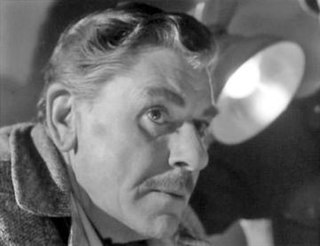
Cecil André Mesritz, known professionally as André Morell, was an English actor. He appeared frequently in theatre, film and on television from the 1930s to the 1970s. His best known screen roles were as Professor Bernard Quatermass in the BBC Television serial Quatermass and the Pit (1958–59), and as Doctor Watson in the Hammer Film Productions version of The Hound of the Baskervilles (1959). He also appeared in the films The Bridge on the River Kwai (1957) and Ben-Hur (1959), in several of Hammer's horror films throughout the 1960s and in the acclaimed ITV historical drama The Caesars (1968).
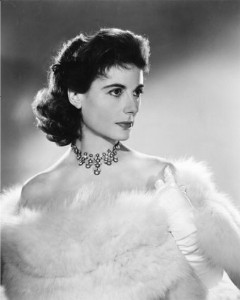
Yvonne Mitchell was an English actress and author. After beginning her acting career in theatre, Mitchell progressed to films in the late 1940s. Her roles include Julia in the 1954 BBC adaptation of George Orwell's novel Nineteen Eighty-Four. She retired from acting in 1977.
Ronald Gow was an English dramatist, best known for Love on the Dole (1934).
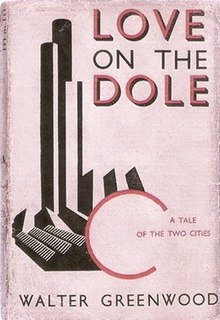
Love on the Dole is a novel by Walter Greenwood, about working class poverty in 1930s Northern England. It has been made into both a play and a film.
Walter Greenwood was an English novelist, best known for the socially influential novel Love on the Dole (1933).
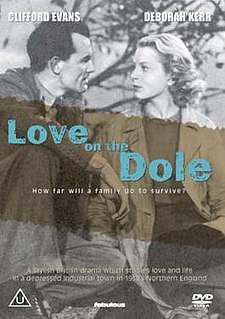
Love on the Dole is a 1941 British drama film starring Deborah Kerr and Clifford Evans. It was adapted from the novel of the same name by Walter Greenwood. It was the first English-made feature film to show English police wielding batons against a crowd.
Love on the Dole is a 1933 novel by Walter Greenwood, adapted into a play by Ronald Gow.

Ruth Dunning was a Welsh actress of stage, television, and film.
Greenpark Productions Ltd is a British documentary film production company, founded by Walter Greenwood in Polperro, Cornwall in 1938. The company relocated to London in 1939. After the war it expanded into making upmarket corporate films. Amongst its roster of directors were Ken Annakin, Ralph Keene and Humphrey Swingler, brother of the poet Randall Swingler.

The Urgent Hangman is a 1938 thriller novel by the British writer Peter Cheyney. It introduced the fictional London-based private detective Slim Callaghan, the first in a series of seven novels as well as two short story collections.

Only Mugs Work is a 1938 melodromatic crime novel by the British writer Walter Greenwood. Greenwood had established his reputation in 1933 with Love on the Dole, set in a district closely modelled on working-class Salford. In this case the setting is shifted to London's Soho, but features a similar blend of realism and drama. It is set amongst the spivs of the capital city. It was one of a number of novels that focused on the activities of the London underworld in the late 1930s including There Ain't No Justice, The House in Greek Street and Night and the City.

Down by the Sea is a 1956 novel by the British writer Walter Greenwood. It is the final entry of a trilogy set in the fictional fishing port of Treeloe in Cornwall. Durrall, the principal protagonist of the previous novel marries a woman and is able to prosper by opening his cottage as a tea house for tourists.

So Brief the Spring is a 1952 novel by the British writer Walter Greenwood. It is the first in the author's trilogy set in the fictional fishing port of Treeloe in Cornwall. It was developed out of a play which Greenwood had written in 1945. The novel is dedicated to Robert Newton who appeared in the play. It focuses on Randy Jollifer, formerly of the Royal Navy, attempting to settle down to postwar life in his home town. The book and its sequels sold steadily, without enjoying the spectacular popularity of his best-known work Love on the Dole.
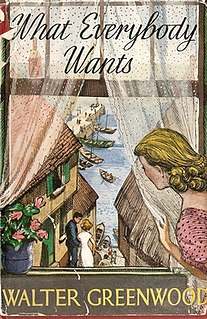
What Everybody Wants is a 1954 novel by the British writer Walter Greenwood. It is the second of a trilogy set in the fictional fishing port of Treeloe in Cornwall during the postwar years. While the principal character of the first novel Randy Jollifer reappears, there is a shift to focus on the life of Darky Durrant. Durrant is a local poacher of gypsy heritage who, despite a distinguished war record as a commando, lives on the margins of society.

The Secret Kingdom is a 1938 novel by the British writer Walter Greenwood. Like his best-known novel Love on the Dole it is set in Salford. It portrays the working-class socialist Byron family, and particularly the eldest daughter Paula who tries to establish an independent identity after finding working a parlour maid. She encounters Bert Treville in nearby Manchester and the two begin a courtship. After his death due to heavy drinking, she brings up her son Lance as a single-mother, throwing her effort into her talented child she is vindicated when he emerges as a talented concert pianist - performing on national radio in the final scene.

His Worship the Mayor is a 1934 novel by the British writer Walter Greenwood. It was his second novel, following on from the success of his bestselling debut Love on the Dole the previous year. His new work drew on his experience as a Labour councillor, and focuses on corruption in local government a theme also addressed in Winifred Holtby’s South Riding. The novel features Sam Grundy, the bookmaker who had appeared in Love on the Dole.
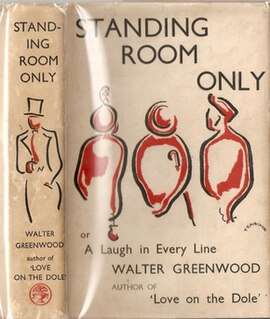
Standing Room Only is a 1936 comedy novel by the British writer Walter Greenwood. It was his third novel. Like his previous two, including his bestselling debut Love on the Dole, the work is partly set in his native Salford. The novel was somewhat self-reflexive as the protagonist Henry Ormerod strongly resembles Greenwood's own background and experiences. It was not as critically well-received as his two previous novels.
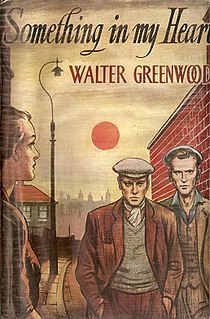
Something in My Heart is a 1944 novel by the British writer Walter Greenwood. It is a loose sequel to his debut and best-known novel Love on the Dole, a 1933 work set in Salford at the height of the Great Depression. This book presented a more optimistic view of a potential postwar future that was absent in the despair in the original novel.
















